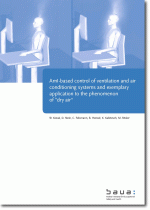What is permitted by the legislation and when employers have to take action
If it is too hot in the workplace, employees’ well-being and health may suffer as a result. This page summarises the measures that have to be taken when the temperature reaches particular levels.
The Workplaces Ordinance (Arbeitsstättenverordnung, ArbStättV) is the main piece of legislation that lays down requirements for workplaces in Germany. The ordinance includes binding provisions governing the following matters connected with workplace room temperatures:
- Annex 3.5 Raumtemperatur (room temperature)
(1) Working spaces not subject to any specific requirements regarding the room temperature from an industrial point of view must have a room temperature beneficial to the health during the period of use taking into consideration the procedures and the physical stress of the employees.
(2) Sanitary, break, and ready rooms, canteens, first aid rooms, and quarters must have a room temperature beneficial to the health during the period of use taking into consideration the specific purpose.
The Workplaces Ordinance does neither include detailed requirements nor does it include measures. Therefore, the employer must perform a risk assessment according to § 3 ArbStättV possibly formulating the corresponding protective measures. Accordingly, the decision regarding the possible room temperature, taking into consideration the boundary conditions mentioned above, is covered by the sphere of responsibility of the employer. Specific information regarding this can be found in the delegated set of rules:
- Workplace rule ASR A3.5 Raumtemperatur (room temperature) from June 2010
4.2 Lufttemperaturen in Räumen (room temperatures in rooms)
(3) "The air temperature in working spaces and the rooms mentioned in section 4 must not exceed +26°C. Item 4.4 is applicable to ambient air temperatures of more than +26°C."
4.4 Arbeitsräume bei einer Außenlufttemperatur über +26 °C (working spaces at an ambient air temperature of more than +26°C)
This item includes a step model for the "case of summer" showing how employees can continue their work at air temperatures in working spaces of up to +30°C, up to +35°C, and more than +35°C. Depending on the air temperature, certain protective measures are required for the employees. The following table summarises the provisions of item 4.4.
| Air temperature in working spaces | Boundary condition and measures |
|---|---|
| up to +30°C | If the ambient air temperature exceeds +26°C and suitable solar protection is already used, the employer is to take measures according to table 4 of the ASR A3.5. In individual cases (e.g. wearing of PPE, performing hard work, presence of health-biased employees or employees with a special need for protection), an adapted risk assessment must be used to make a decision on additional measures. |
| up to +35°C | The employer must take efficient measures according to table 4 of the ASR A3.5. |
| more than 35°C | During the time this temperature is exceeded, the room is not suitable for being used as a working space if no measures are taken, e.g. as for working under heat (examples are mentioned in the ASR). |
Thus, there is no general statutory compulsion regarding the compliance with a maximum temperature in workplaces. In the so-called tolerance range over +26°C, it is possible to perform work for the duration of one shift under certain conditions and certain protective measures without this resulting in any adverse effects on the health. An assessment of the health conduciveness must be performed particularly regarding the individual cases mentioned in the ASR A3.5 in the form of a risk assessment, including an additional verification of the individual climate variables
- air temperature,
- humidity,
- air velocity, and
- thermal radiation,
or possibly by means of climate sum measures.
In so doing,
- the work hardness,
- the predominant posture,
- the work regime (e.g. break times), as well as
- the clothes of the employees
must be taken into consideration. The personal physical condition, the adaptation to the heat (acclimatisation), and the loss of water of the body (dehydration) play an essential role. Furthermore, it must be observed whether employees with a special need for protection are present, e.g. adolescents, elderly, pregnant women, or nursing mothers. Due to the complexity of the question, such a verification should be performed by experts on site. For this, consultation with the safety expert, the company doctor, or the competent authority is recommendable (e.g. Trade Supervisory Board or accident insurer).
Practical information for measuring and evaluating the climate parameters, as well as on protective measures when working under the effects of heat can be found in the information brochures of the accident insurers and the LASI. For example, a nomograph (risk graph climate) is included in the DGUV information 215-510. This can be used to quickly and readily estimate the situation in a working space based on the air temperature and the humidity.
